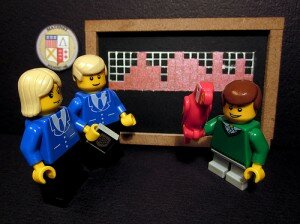 Many kids-turned-adults have fond memories of hours spent on the floor, assembling ships and cities from tiny plastic Lego building blocks. As it turns out, research of early childhood development shows that this wasn’t just “fun time” for preschoolers and elementary school students, but actually can help develop spatial reasoning and building skills.
Many kids-turned-adults have fond memories of hours spent on the floor, assembling ships and cities from tiny plastic Lego building blocks. As it turns out, research of early childhood development shows that this wasn’t just “fun time” for preschoolers and elementary school students, but actually can help develop spatial reasoning and building skills.
Spatial reasoning helps students learn about context, width, and height, while recreating complex models. After six weeks spent with Lego, students who had access to the blocks were “significantly more aware of context and spatial considerations, and they were able to more easily recreate the models that researchers presented them with.”
The study proved a few other interesting qualities of Lego, including that the hands-on material helps students pick up mathematics more effectively to show “markedly higher” performance on math assessments. Legos can build social skills, boost critical reading and writing skills, and even help teach languages to ESL learners. You can read more about the full study , but it seems as if there’s a bounty of benefits that come along with being a Lego learner from a young age.
They may not know it, but youngsters playing with their Legos are also starting their homework early for robotics competitions in their future. The reports that at the University of Nebraska Lincoln, Nebraska 4-H organizes a yearly league called the Nebraska FIRST LEGO League, which utilizes Lego-building skills to encourage interest in STEM subjects. “We developed the curriculum, and we did it because we wanted more kids interested in STEM and STEM careers,” says Bradley Barker, an associate professor at UNL. “And you know, robotics integrates all the subject areas of STEM.”
Here’s how it works: 117 teams from Nebraska (including some kids as young as 7 or 8) compete in a league with more than 80 countries and more than 233,000 youth. All are under the age of 14, and practice until December and January when the qualification events begin. The top three teams from the State Championship move on to the international competition, held in St. Louis (there’s also an American championship in California).
Part of the competition is creating autonomous robots, which are made of Legos. The robots must solve different challenges during the two-and-a half minute competition: “It’s very intense, but it’s fun. It’s just like a sporting event. We have music; we have cameras, it’s high energy.” Barker tell the Daily Nebraskan that he’s also seen students move from the Lego League to studying STEM in college—he even has a student who emerged from the program and now studies computer engineering at UNL.
This year, the Lego Group and FLL have themed the challenge “Trash Trek,” and will create robots that collect, sort, and help with smart production and reuse. Learn more about the challenge . If you’re interested in finding out what the FLL league looks like, there’s some fantastic videos on YouTube, including and .
—
photo credit: via
 Official Nebraska Government Website
Official Nebraska Government Website
